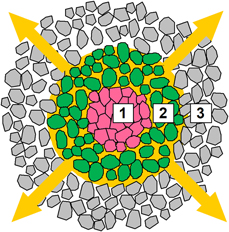Crossref Citations
This article has been cited by the following publications. This list is generated based on data provided by
Crossref.
Egorov, S. V.
Eremeev, A. G.
Plotnikov, I. V.
Rybakov, K. I.
Sorokin, A. A.
Kholoptsev, V. V.
Balabanov, S. S.
Rostokina, E. E.
and
Bykov, Yu. V.
2020.
Application of Millimeter-Wave Radiation for Manufacture of Ceramic Items Using Additive Methods.
Radiophysics and Quantum Electronics,
Vol. 63,
Issue. 7,
p.
522.
Tsuchida, Takayuki
Fukushima, Jun
and
Takizawa, Hirotsugu
2021.
Decrease in the Crystallite Diameter of Solid Crystalline Magnetite around the Curie Temperature by Microwave Magnetic Fields Irradiation.
Nanomaterials,
Vol. 11,
Issue. 4,
p.
984.
Egorov, S.V.
Eremeev, A.G.
Kholoptsev, V.V.
Plotnikov, I.V.
Rybakov, K.I.
Sorokin, A.A.
Balabanov, S.S.
Rostokina, E.Ye.
and
Bykov, Yu.V.
2021.
Rapid microwave sintering of zinc oxide-based varistor ceramics.
Journal of the European Ceramic Society,
Vol. 41,
Issue. 13,
p.
6508.
Renaux, Maxence
Méresse, Damien
Pellé, Julien
Thuault, Anthony
Morin, Céline
Nivot, Christelle
and
Courtois, Christian
2021.
Mechanical modelling of microwave sintering and experimental validation on an alumina powder.
Journal of the European Ceramic Society,
Vol. 41,
Issue. 13,
p.
6617.
Egorov, S.V.
Eremeev, A.G.
Kholoptsev, V.V.
Plotnikov, I.V.
Rybakov, K.I.
Sorokin, A.A.
Balabanov, S.S.
Rostokina, E.Ye.
and
Bykov, Yu.V.
2021.
Rapid microwave sintering of alumina ceramics with an addition of carbon nanotubes.
Ceramics International,
Vol. 47,
Issue. 4,
p.
4604.
Egorov, S.V.
Eremeev, A.G.
Kholoptsev, V.V.
Plotnikov, I.V.
Rybakov, K.I.
Sorokin, A.A.
Balabanov, S.S.
and
Rostokina, E.Ye.
2022.
Rapid sintering of barium titanate ceramics using direct and susceptor-assisted microwave heating.
Materialia,
Vol. 24,
Issue. ,
p.
101513.
Sadykov, Vladislav A.
Eremeev, Nikita F.
Sadovskaya, Ekaterina M.
Shlyakhtina, Anna V.
Pikalova, Elena Yu
Osinkin, Denis A.
and
Yaremchenko, Aleksey A.
2022.
Design of materials for solid oxide fuel cells, permselective membranes, and catalysts for biofuel transformation into syngas and hydrogen based on fundamental studies of their real structure, transport properties, and surface reactivity.
Current Opinion in Green and Sustainable Chemistry,
Vol. 33,
Issue. ,
p.
100558.
Venkata Nagaraju, K. Veera
Kumaran, S.
and
Rao, T. Srinivasa
2022.
Densification kinetics of P/M austenitic (316L) stainless steels processed by rapid microwave hybrid heating method at various conditions.
Advances in Materials and Processing Technologies,
Vol. 8,
Issue. 3,
p.
3539.
Röhrens, Daniel
Abouserie, Ahed
Wang, Bangfen
Haselmann, Greta
and
Simon, Ulrich
2022.
Microwave-Assisted CO Oxidation over Perovskites as a Model Reaction for Exhaust Aftertreatment—A Critical Assessment of Opportunities and Challenges.
Catalysts,
Vol. 12,
Issue. 7,
p.
802.
Wang, Liangyuan
Shen, Lei
Li, Yongcun
Wang, Yuanjie
Xiao, Yu
Zhang, Xingyi
Xu, Feng
and
Hu, Xiaofang
2022.
In situ SR-CT Experimental Study on the Directional Sintering of High-Temperature Superconductor YBCO Materials in the Microwave Fields.
Acta Metallurgica Sinica (English Letters),
Vol. 35,
Issue. 1,
p.
67.
Egorov, S. V.
Eremeev, A. G.
Kholoptsev, V. V.
Plotnikov, I. V.
Rybakov, K. I.
and
Sorokin, A. A.
2022.
Implementation of rapid microwave sintering using a 24 GHz gyrotron system.
Review of Scientific Instruments,
Vol. 93,
Issue. 6,
Egorov, Sergei V.
Eremeev, Anatoly G.
Kholoptsev, Vladislav V.
Plotnikov, Ivan V.
Rybakov, Kirill I.
Sorokin, Andrei A.
Rostokina, Elena Ye.
and
Balabanov, Stanislav S.
2023.
Effect of absorbed power and dopant content on densification during rapid microwave sintering of Bi2O3‐doped ZnO.
Journal of the American Ceramic Society,
Vol. 106,
Issue. 2,
p.
878.
Manière, Charles
Harnois, Christelle
Riquet, Guillaume
Grippi, Thomas
Behar‐Lafenetre, Stéphanie
and
Marinel, Sylvain
2023.
Rapid microwave sintering of centimetric zirconia: Scalability and electromagnetic‐thermal‐fluid‐dynamic simulation.
Journal of the American Ceramic Society,
Vol. 106,
Issue. 2,
p.
848.
Egorov, S.V.
Eremeev, A.G.
Kholoptsev, V.V.
Plotnikov, I.V.
Rybakov, K.I.
Sorokin, A.A.
Balabanov, S.S.
and
Rostokina, E.Ye.
2023.
Rapid microwave sintering of functional electroceramic materials.
Ceramics International,
Vol. 49,
Issue. 14,
p.
24222.
Egorov, S.V.
Eremeev, A.G.
Kholoptsev, V.V.
Plotnikov, I.V.
Rybakov, K.I.
Sorokin, A.A.
Balabanov, S.S.
and
Rostokina, E.Ye.
2024.
Rapid microwave sintering of gadolinia-doped ceria.
Materialia,
Vol. 33,
Issue. ,
p.
101980.






